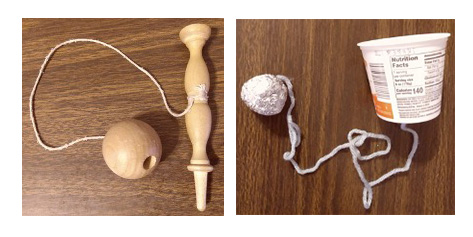5 Games to Make and Play with Family
Children in the 18th century used what they had to make toys. What do you have around the house that can be recycled or reused to make a modern version of some of their toys? Think about ways you can improve your creations and challenge family and friends to make the best version and most creative rules! *
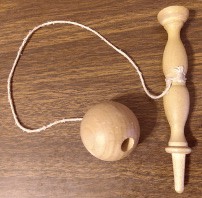
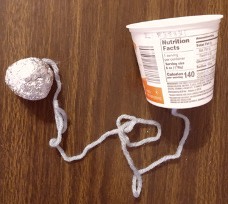
1. Cup and Ball
History: Perhaps one of the most universal toys from the past is cup and ball. Many sources agree that this game originated in France as a bilboquet, but it has since traveled around the world and taken on different names and slightly different shapes. In Japan, a similar toy is called a kendama. What new shape will yours take on?
How to Play: Try to catch the ball in the cup. Which method works best with the style of toy you’ve created? A swinging motion, straight up or something else?
How to make your own: Poke a hole in any plastic cup; you may need an adult’s help. Feed a string through and tie a knot. On the other end of the string, tie a wadded-up piece of aluminum foil.
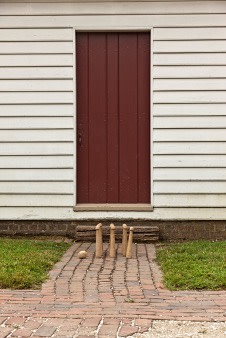
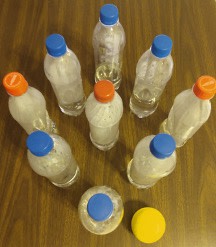
2. Nine Pins
History: Nine pins is another game with a multitude of names and some variation in play. The Dutch brought ninepins to New York and the English brought bowls, another version of the game, to Jamestown. As far back as the 17th century, the game was called skittles, though the specific etymology is uncertain.
How to Play: Use the ball to knock down as many pins as possible in as few rolls as possible. Different from modern bowling, the pins are often set up as a diamond pattern (1-2-3-2-1) but this was also prone to change with the names. Do you have any creative “house rules”?
How to make your own: Partially refill nine water or soda bottles with sand, pebbles, or even water, adjusting the amount for difficulty, the more material the harder to knock down, then arrange and take aim with whatever ball you have handy.
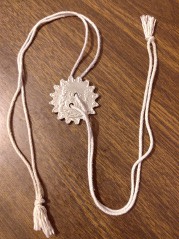
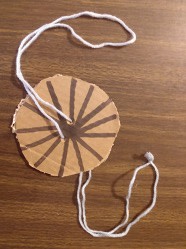
3. Whirligig
History: The origins of this toy are particularly difficult to track down with any certainty. It could be made from a variety of materials from a variety of cultures. An example of this toy was found in excavations of sites in Williamsburg and was made from a Hungarian coin. The one pictured is a replica Spanish Milled Dollar on string.
How to Play: Spin the circle around until the string is tight, then with fluid motion pulse your hands in and out to keep the spinning going. What other materials can you use for the circle?
How to make your own: Cut a cardboard circle and decorate it, then punch two holes, like a button, near the middle. To finish, thread some yarn or string through and tie a knot. Have an adult help with the cutting. Experiment with the size of the circles and the placement of the holes, what is the best combination?
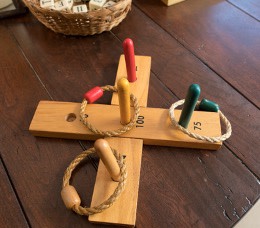
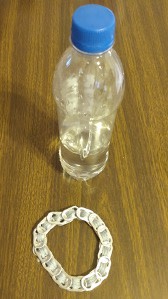
4. Quoits
History: Quoits is a ring toss game, possibly going as far back as Ancient Greece but certainly as old as 14th-century England. “The quoit was the ancient discus with a hole in the middle”. Not everyone had quoits, so they would use what they had, eventually leading to the game of horseshoes.
How to Play: Try to toss more of your rings around the bottle than your opponent or beat your personal best. What is the farthest distance you can toss from and still get the ring on the bottle?
How to make your own: Weave pop tabs together with a ribbon or pipe cleaner until an appropriate size to go around your post, which could be as simple as one of the water bottles from nine pins.
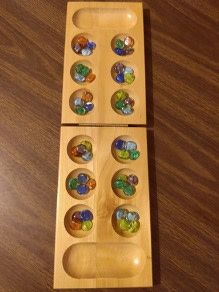
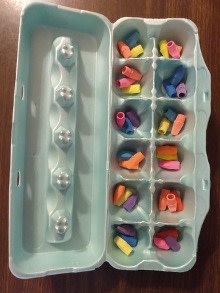
5. Mancala
History: Versions of Mancala were played in Egypt by 1400 BC. It spread throughout Africa, and eventually there was a version in almost every African country — each with their own names and variations in play. The most common variations are in how many bins for the pieces to move around. Enslaved Africans brought knowledge of this game to the Americas when they were taken into slavery.
How to Play: Start the game with three pieces in each bin. In store-bought games there is often an oblong scoring bin at either end of the board. Since an egg carton does not have this bin, leave space for the scoring pieces on the table. This is a two-player game with each player choosing a side of the board. The goal is to get more pieces in your scoring bin than your opponent. One player goes first, picking up all the pieces in a bin and redistributing them counter-clockwise, one-by-one in the following bins. If the player’s last piece lands on their side in a bin that is not empty, their turn continues by picking up the pieces in the last bin they added to and redistributing those in the same manner. When the player gets to the end of a row, they skip their opponent’s scoring bin and continue. If they land in an empty bin, their turn is over; if the last piece lands in their own scoring bin, they get another turn. The other player’s turn would work the same way and play continues until there are no pieces left on one side, the player with pieces on their side gets to add them to their score.
How to make your own: Divide 36-48 pebbles, buttons, pennies etc., evenly between the 12 wells of an egg carton, continue play as normal only keep a pile at either end of the carton. If left whole, the carton can be closed again to keep all the pieces together when not in use. For an even more minimalist version, go outside! Draw 12 circles in a sandbox or with sidewalk chalk and play with pebbles, acorns, sweet gum balls or other found natural objects.
Many colonial leaders used enlightenment ideas, such as the scientific method, to improve life for themselves and others. To solve problems, they would research, make a hypothesis, or educated guess, about what changes would fix the problem then try it and measure the results. Above were just a few ideas of modern adaptations of colonial games, what can you do to make them better? Share your projects and tag us! @ColonialWilliamsburg #FunColonialStyle
*Please note that there are many versions of these games (and more if you’re feeling creative). In the spirit of fair play, just be sure all participants agree on the rules before beginning each game.
Kristie Hammond is a former middle and high school history teacher from Ohio (shout out to my former students!). She began her work as an interpreter at Colonial Williamsburg focusing on 18th-century games. When not in costume she enjoys being in nature, listening to audiobooks and working on paint-by-numbers.
Resources
"bilboquet, n.". OED Online. March 2020. Oxford University Press. https://0-www.oed.com.library.mvnu.edu/view/Entry/18941?redirectedFrom=bilboquet& (accessed March 20, 2020).
Carson, Jane. Colonial Virginians at Play. Williamsburg, Virginia: Colonial Williamsburg, 1989.
Jennifer Prior. The Games of Africa. (U.S.A.: Harper Collins Publishing, 1994), pp.13-17.
Provenzo, Asterie Baker and Eugene F. Provenzo, Jr. Play It Again: Historic Board Games You Can Make and Play. Englewood Cliffs, New Jersey: Princeton-Hall, Inc., 1981, pp.110-112.
"skittle, n.". OED Online. March 2020. Oxford University Press. https://0-www.oed.com.library.mvnu.edu/view/Entry/181055?result=1&rskey=nCB74T& (accessed March 20, 2020).
